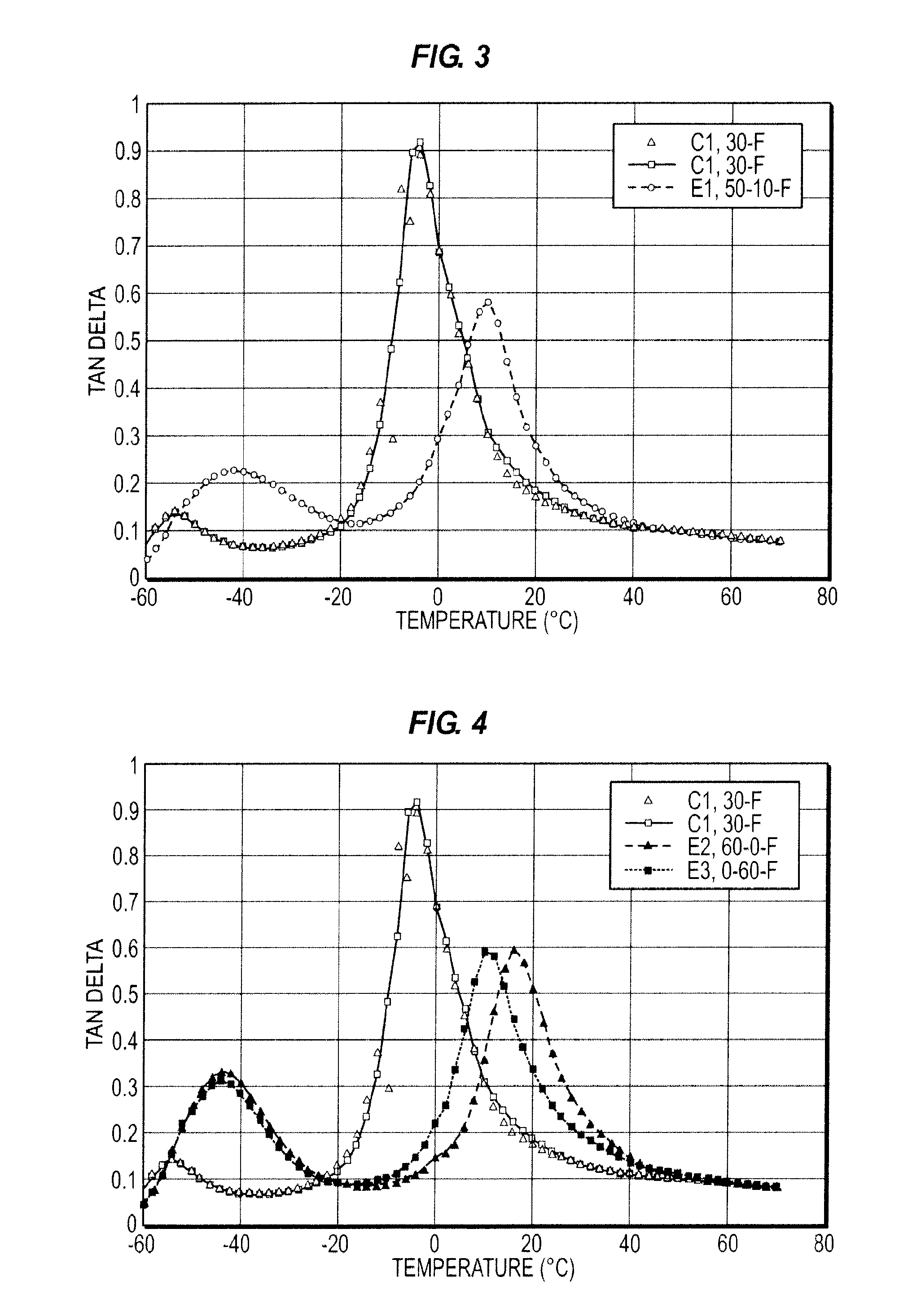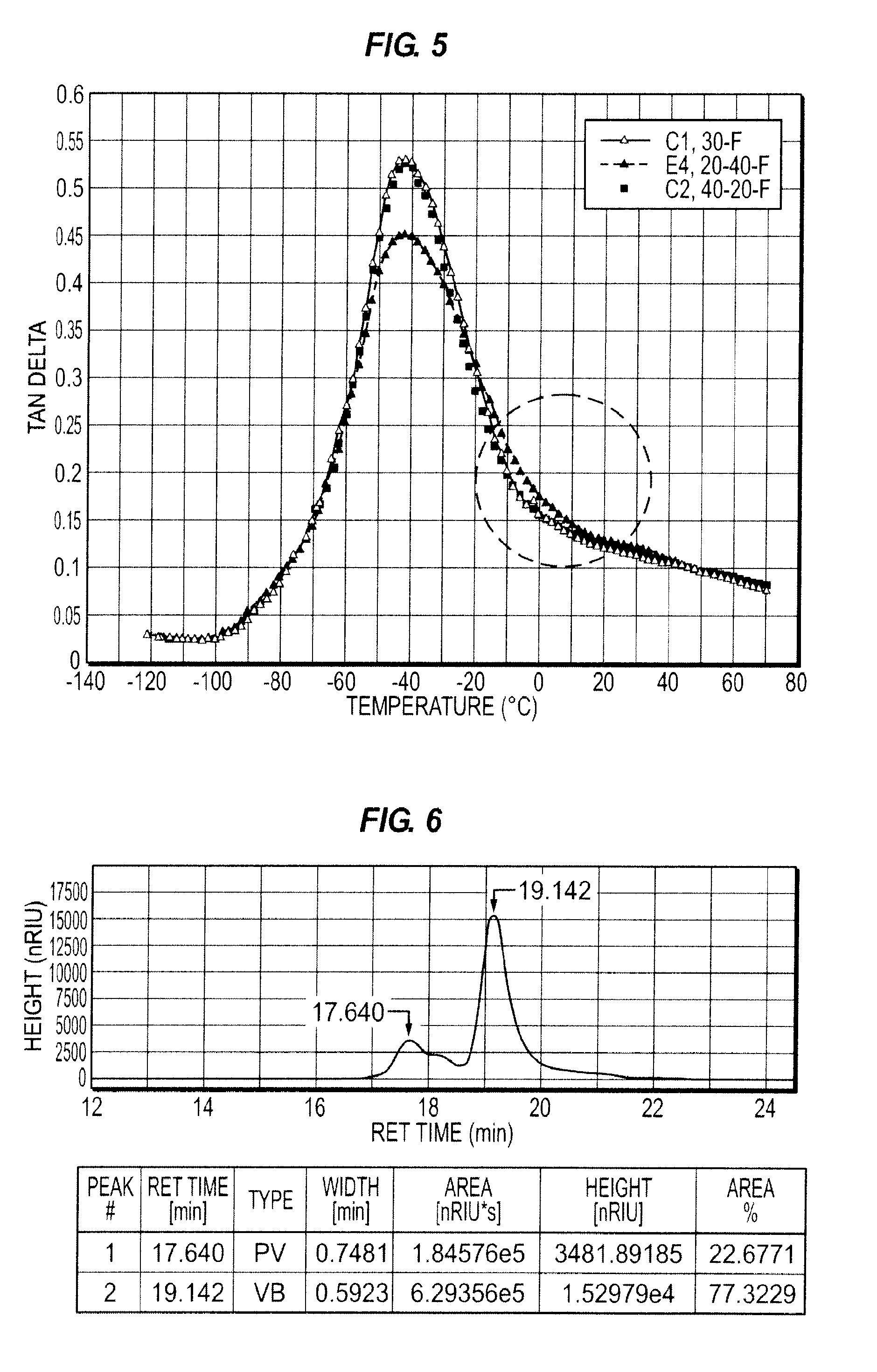Styrene butadiene rubber with novel styrene incorporation
a technology of styrene butadiene and styrene, which is applied in the direction of rolling resistance optimization, tire parts, transportation and packaging, etc., can solve the problems of poor hbu, rolling resistance and/or abrasion resistance, deficient hbu and rolling resistance properties, and poor cost-effectiveness of dilithio initiators, so as to improve grip, tear and/or braking performance, the effect of improving properties
- Summary
- Abstract
- Description
- Claims
- Application Information
AI Technical Summary
Benefits of technology
Problems solved by technology
Method used
Image
Examples
polymer example 1
[0088]Cyclohexane (mCyclohexan=4504.2 g), Butadiene (m1,Bd=122.9 g), styrene (m1,St=248.78 g) and 14.8219 mmol TMEDA (mTMEDA=73.38 g of the solution in cyclohexane) were charged to an airfree 10 liter reactor and the stirred mixture was heated up to 35° C. Then n-Butyllithium was charged dropwise to react the impurities until the color of the reaction mixture changed to yellowish (Titration Step, n-butyllithium solution in cyclohexane mNBL, titration=5.91 g). After that the recipe amount of 6.23 mmol n-butyllithium (as solution in cyclohexane mNBL, Recipe=15.82 g) corresponding to the target molecular weight of the polymer was charged immediately via pump to start the polymerization. The start time of the charge of the main amount of n-butyllithium was used as the start time of the polymerization. In parallel the temperature was increased by heating or cooling via hot water in the wall of the reactors beginning with the charge of the main amount of n-butyllithium to the final polyme...
polymer example 2
[0094]4526.8 g cyclohexane, 75.5 g butadiene, 298.82 g styrene and 14.8219 mmol TMEDA were charged to an airfree 10 liter reactor and the stirred mixture was heated up to 35° C. Then n-Butyllithium was charged dropwise to react the impurities until the color of the reaction mixture changed to yellowish (Titration Step). After that the recipe amount of 6.55 mmol n-butyllithium corresponding to the target molecular weight of the polymer was charged immediately via a pump to start the polymerization. The start time of the charge of the main amount of n-butyllithium was used as the start time of the polymerization. In parallel the temperature was increased by heating or cooling via hot water in the wall of the reactors beginning with the charge of the main amount of n-butyllithium to the final polymerization temperature Tpm of 55° C. with a rate of 0.67° C. / min to accelerate the polymerization reaction and shorten the reaction time. After 5 minutes the first charge step of 79.49 g butad...
polymer example 3
[0096]4540.8 g cyclohexane, 481.8 g butadiene, and 7.9659 mmol TMEDA were charged to an airfree 10 liter reactor and the stirred mixture was heated up to 35° C. Then n-Butyllithium was charged dropwise to react the impurities until the color of the reaction mixture changed to yellowish (Titration Step). After that the recipe amount of 5.29 mmol n-butyllithium corresponding to the target molecular weight of the polymer was charged immediately via a pump to start the polymerization. The start time of the charge of the main amount of n-butyllithium was used as the start time of the polymerization. In parallel the temperature was increased by heating or cooling via water in the wall of the reactors beginning with the charge of the main amount of n-butyllithium to the final polymerization temperature Tpm of 55° C. with a rate of 0.67 C / min to accelerate the polymerization reaction and shorten the reaction time. The reaction was allowed to complete within 40 minutes to polymerize the firs...
PUM
| Property | Measurement | Unit |
|---|---|---|
| glass transition temperatures | aaaaa | aaaaa |
| glass transition temperatures | aaaaa | aaaaa |
| glass transition temperatures | aaaaa | aaaaa |
Abstract
Description
Claims
Application Information
 Login to View More
Login to View More - R&D
- Intellectual Property
- Life Sciences
- Materials
- Tech Scout
- Unparalleled Data Quality
- Higher Quality Content
- 60% Fewer Hallucinations
Browse by: Latest US Patents, China's latest patents, Technical Efficacy Thesaurus, Application Domain, Technology Topic, Popular Technical Reports.
© 2025 PatSnap. All rights reserved.Legal|Privacy policy|Modern Slavery Act Transparency Statement|Sitemap|About US| Contact US: help@patsnap.com



